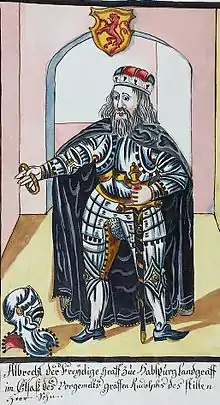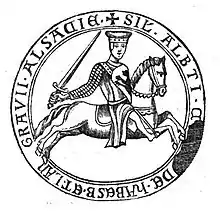Albert IV, Count of Habsburg
Albert IV (or Albert the Wise) (c. 1188 – December 13, 1239) was Count of Habsburg in the Aargau and a progenitor of the royal House of Habsburg.
Albert IV, Count of Habsburg | |
|---|---|
 | |
| Born | c. 1188 |
| Died | 13 December 1239 Ashkelon |
| Noble family | House of Habsburg |
| Spouse(s) | Hedwig of Kyburg |
| Issue | Rudolf I of Germany |
| Father | Rudolph II, Count of Habsburg |
| Mother | Agnes of Staufen |
He was the son of Count Rudolph II of Habsburg and Agnes of Staufen. About 1217, Albert married Hedwig (Heilwig),[1] daughter of Count Ulrich of Kyburg (died 1237) and Anna of Zähringen. He was present at the signing of the Golden Bull of Rimini in March 1226. Upon the death of his father in 1232, he divided his family's estates with his brother Rudolph III, whereby he retained the ancestral seat at Habsburg Castle. A follower of Emperor Frederick II of Hohenstaufen, he took part in the Barons' Crusade of 1239 with King Theobald I of Navarre and died near Ashkelon.
Albert was the father of King Rudolf I of Germany.[2]
A cause for Albert's beatification in the Catholic Church was opened on 4 September 1908, and he was declared a Servant of God.[3]
 Seal of Albert IV, Count of Habsburg, inscribed in Latin (with abbreviations): SIGILLUM ALBERTI (COMIS) DE HABESB(URG) ET LANGRAVII ALSACTIAE ("seal of Albert of Habsburg, Count of Habsburg and Langrave of Alsace")
Seal of Albert IV, Count of Habsburg, inscribed in Latin (with abbreviations): SIGILLUM ALBERTI (COMIS) DE HABESB(URG) ET LANGRAVII ALSACTIAE ("seal of Albert of Habsburg, Count of Habsburg and Langrave of Alsace") Coat-of-arms of the count of Habsburg
Coat-of-arms of the count of Habsburg Franz Ferdinard and his wife Sophie those mutual ancestor was Albert IV
Franz Ferdinard and his wife Sophie those mutual ancestor was Albert IV
References
- Emerton 1917, p. 76.
- Berenger 2013, p. 13.
- Index ac status causarum beatificationis servorum dei et canonizationis beatorum (in Latin). Typis polyglottis vaticanis. January 1953. p. 5.
Sources
- Berenger, Jean (2013). Simpson, C.A. (ed.). A History of the Habsburg Empire 1273-1700. Routledge.
- Emerton, Ephraim (1917). The Beginnings of Modern Europe (1250-1450). Ginn and Company.